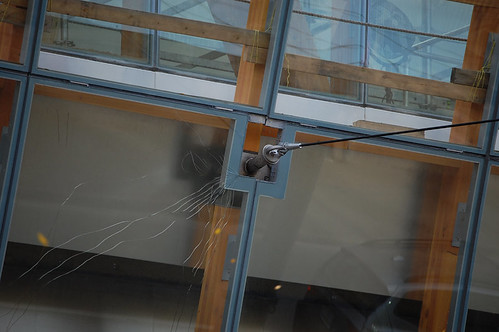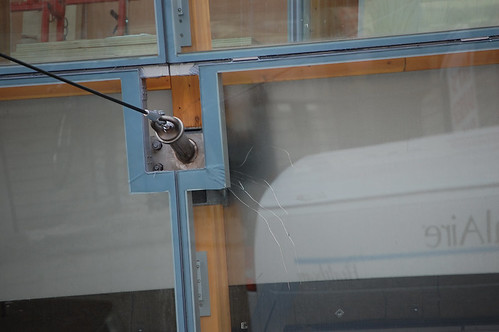
Thanks to a City of Toronto project to reduce pole pollution, Dundas Street West is looking a little less cluttered these days. As part of the redesign of the Art Gallery of Ontario, TTC streetcar poles have been removed; supporting crosswires now run directly into eyelets all along the front of the new building. However, when the wires were first installed two weeks ago, the glass cracked under the tension of the wires (photo above and below). You can see photos of the replacement on Torontoist. City staff indicated the geometry of the eyelet, where the wires attach to the glass, had to be tweaked to stop future stress fractures.
This location is the first of a city-wide attempt to eliminate redundant hydro and streetcar poles, but it is costly and brings about challenges such as trying to consolidate TTC, traffic signals, and street light details (all of which are run by different departments or agencies). Nevertheless, the City hopes that reducing the number of poles will reduce complaints and liability, improve streetscape aesthetics, and remove sidewalk clutter.


15 comments
Bravo on the initiative. One thing that makes Toronto rare among big North American cities is the ubiquitous presence of all those poles, not only for streetcars but for electric and TV wiring. It’s charming in a shabby sort of way, and kind of populist with all the flyers stapled too them, but downtown the poles tend to be concrete and too much concrete is definitely an eyesore, especially in stree-tree-deprived commercial areas. (The decorative steel poles on Spadina are not so bad.)
Very sloppy work on the cracked glass – architects trying to do an engineer’s job. Creating a proper load path for tensile elements is not that difficult if you can bother to include a structural engineer at the meeting where the exterior cladding is being discussed. Tsk tsk.
http://www.bombardier.com/en/transportation/sustainability/technology/primove-catenary-free-operation?docID=0901260d800486ab
From the Bombardier web site: “Bombardier’s new PRIMOVE system enables FLEXITY trams to operate catenary-free over varying distances” While they are only at present testing, it may be possible to operate the new LRV’s without the overhead wires we have all grown accustomed to. Don’t know if they have tested the system out on existing LRV’s.
Pole pollution has become a serious problem, and the transfers of responsibility between agencies have not helped one bit.
The TTC has two generations of poles in many locations, and often the older one is awaiting the removal of one fixture by some other “guest” agency.
Some lighting designs require poles on different spacings from poles that hold utilities. The original design for St. Clair West was going to have lighting poles about 1.5 times as far apart as overhead poles, and the TTC was adamant that the overhead poles be in the right-of-way.
What was actually built was lighting poles on almost exactly the same spacing as the overhead poles, and the streetcar wires could have been held up by spans just as they had for the last 70 years.
Some “pedestrian” lighting is mounted on short poles that are spaced with no regard for the surrounding utility poles.
It goes on and on.
Then there’s the issue of getting rid of sodium vapour lighting (yellow), but that’s another thread.
Steve> See Alfred Holden’s piece on streetlights in the latest Spacing print mag.
Shawn> Yes I have already seen that piece. Alfred and I have talked about street lighting on many occasions, and we were both part of the group responsible for the introduction of colour-correct MH lighting in “acorn” fixtures to the old City of Toronto.
Sadly, this initiative seems to have stopped dead in its tracks at the city boundary, and the colour spectrum of street lighting is an ignored part of urban design. This is one more of those cases where old-style designs that were good enough for cars takes precedence over modern developments that make streets attractive for people.
At least the newer LED lighting isn’t orange, but it’s a tad too blue for my liking. A lot of work went into getting MH “just right” for TV broadcasts at stadiums, and the least we can do is to make our streets as attractive as possible at night.
I am a little baffled by the installation of huge and very ugly wooden poles at Young and Shuter. Just last week the city dug holes and put them in, with supporting wires running along the sidewalk. The area was already imposing,. very busy with poles and furniture everywhere, and now it looks completely ragged.
Any idea why they are going back to wood poles in the middle of the sidewalk?
Poles pollution? What is that, a joke? Besides streetcar wires, all the other wires should be buried, at least downtown. Every road construction project should include a project to bury the wires. This has both practical and aesthetic benefits.
I’m with uSkyscraper – there’s no way that the tension of the wires should be applied to the glass. Done properly, it should be handled by the structural element behind it.
It looks like the failure is actually at the notch in the corner of the window, and might rather be to do with the geometry of the window and residual stress in the glass, and not the cable. Stress analysis is tricky, though.
There’s actually a City initiative to reduce pole pollution? Does it have a name? Forgive my scepticism…but most public works in Toronto give the impression that City Hall isn’t even aware that maybe, just maybe, lining our main streets with rotting tree trunks holding up dozens of ugly wires isn’t the best idea.
Incidentally, Dundas has some of the worst examples.
Unfortunately, it’s a classic divided-jurisdiction problem: getting the City, TTC, and Hydro to co-operate is nearly impossible.
Upon closer inspection, I agree with scruss that the issue is probably what happens to a big sheet of glass when you notch a corner out of it. The cables seem to go onto a steel eyelet that is attached to a metal strut. Cutting the glass probably created a bad stress condition at the inset corner, which led to the other cracks, purely from self-weight, wind, and other forces on the glass alone.
Ah, good old stress concentration at corners.
My theory is that these inside-corners were cut using an inferior method than the one used for cutting the rest of glass resulting in imperfections (micro-crack) at that corner, which propagated as a result of cyclic loading from the passing of streetcars.
The San Diego hydro system levies a small additional fee on hydro bills to pay for systematic burial of overhead wires. Maybe something that Mayor Miller could push? It is amazing to me to see that when hydro lines are upgraded (e.g. recently along Dovercourt) that they opted to use the same dead tree and overhead wiring system that has been used for more than a century. Admittedly, some of the crossbars were eliminated but the wires themselves still create a lot of visual clutter.
I seem to recall reading somewhere that BIAs can apply for wires to be put underground but at their expense rather than a city wide programme. Can anyone confirm that?
It is important to keep our city clean and healthy
Discipline is the answer to our pollution problems.